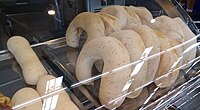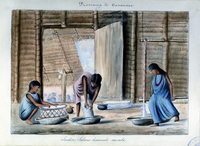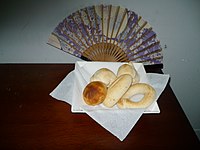
Argentine cuisine is described as a blending of cultures, from the Indigenous peoples of Argentina who focused on ingredients such as humita, potatoes, cassava, peppers, tomatoes, beans, and yerba mate, to Mediterranean influences brought by the Spanish during the colonial period. This led to cultural blending of criollos, Indigenous, and sub-Saharan African in the cuisine. Later, this was complemented by the significant influx of Italian and Spanish immigrants to Argentina during the 19th and 20th centuries, who incorporated plenty of their food customs and dishes such as pizzas, pasta and Spanish tortillas.

Tapioca is a starch extracted from the tubers of the cassava plant, a species native to the North and Northeast regions of Brazil, but whose use is now spread throughout South America. It is a perennial shrub adapted to the hot conditions of tropical lowlands. Cassava copes better with poor soils than many other food plants.

Brazilian cuisine is the set of cooking practices and traditions of Brazil, and is characterized by European, Amerindian, African, and Asian influences. It varies greatly by region, reflecting the country's mix of native and immigrant populations, and its continental size as well. This has created a national cuisine marked by the preservation of regional differences.

Cartago is a city in southwestern Colombia, about 187 miles (301 km) west of Bogotá. It is in the extreme northern portion of the Valle del Cauca. It is located very close to the city of Pereira, Risaralda about a 20-minute drive. It is the sixth largest city in Valle after Cali, Palmira, Buenaventura, Tuluá and Jamundí. Per the 2018 Colombian census, Cartago's population was 142,902.
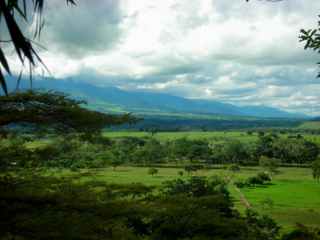
The Llanos is a vast tropical grassland plain situated to the east of the Andes in Colombia and Venezuela, in northwestern South America. It is an ecoregion of the tropical and subtropical grasslands, savannas, and shrublands biome.

The Meta River is a major left tributary of the Orinoco River in eastern Colombia and southern Venezuela, South America. The Meta originates in the Eastern Ranges of the Andes and flows through the Meta Department, Colombia as the confluence of the Humea, Guatiquía and Guayuriba rivers. It flows east-northeastward across the Llanos Orientales of Colombia following the direction of the Meta Fault. The Meta forms the northern boundary of Vichada Department, first with Casanare Department, then with Arauca Department, and finally with Venezuela, down to Puerto Carreño where it flows into the Orinoco.

Chipa is a type of small, baked, cheese-flavored rolls, a popular snack and breakfast food in Paraguay. The recipe has existed since the 18th century and its origins lie with the Guaraní people of Asunción. It is inexpensive and often sold from streetside stands and on buses by vendors carrying a large basket with the warm chipa wrapped in a cloth.
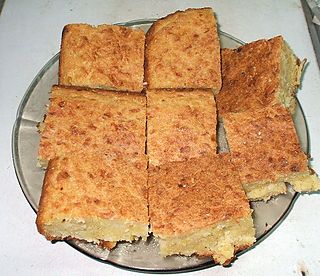
Sopa paraguaya is a traditional food of the Paraguayan cuisine similar to corn bread. It is spongy & soft. Corn flour, cheese, onion and milk or whey are common ingredients. It is a cake rich in caloric and protein content.

The Guahibo people are an indigenous people native to the Llanos or savanna plains in eastern Colombia and in southern Venezuela near the Colombian border. Their population was estimated at 23,772 people in 1998.

Paz de Ariporo is a town and municipality in the Department of Casanare, Colombia.

Puracé is a town and municipality in the Cauca Department, Colombia.

Vori vori is a thick, yellow soup with little balls made of corn flour, and cheese, and it's traditional of the Paraguayan cuisine. It is essentially of Cario-Guarani and Sephardic origins, and derives from one of the commemorative dishes of the Passover as it derives from the Matza balls, replacing the wheat semolina with the corn flour of the Carios.

Mbeju is a starch cake sometimes made with fariña or manioc flour typical of Paraguay. The recipe has existed since the 18th century and its origins lie with the indigenous Cario-Guarani people that lived in the Asunción and its surroundings.

The chipa guasu is a cake made with corn grains, onions and Paraguayan cheese. It is one of 70 varieties of chipa, a traditional set of side dishes from Paraguay. It is often served in asados.

A great variety of cassava-based dishes are consumed in the regions where cassava is cultivated, and the ingredient is included many national or ethnic specialities.
Saliba is an indigenous language of Eastern Colombia and Venezuela. Saliba was used by Jesuit missionaries in the 17th century to communicate with indigenous peoples of the Meta, Orinoco, and Vichada valleys. An 1856 watercolor by Manuel María Paz is an early depiction of the Saliva people in Casanare Province.

Popayán Province was first a Spanish jurisdiction under the Royal Audience of Quito and the Royal Audience of Santafé, and after the independence one of the provinces of the Cauca Department, later becoming the Republic of New Granada.
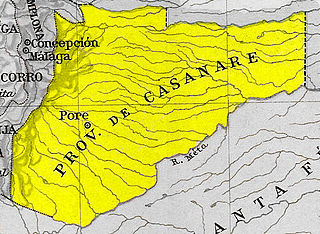
Casanare Province was one of the provinces of Gran Colombia.

Manuel María Paz Delgado was a Colombian cartographer, military officer, artist and watercolorist.
Sopa correntina is a traditional food of the Corrientes Province and part of the Chaco Province, a product of the absorption of the Guaraní culture and mainly of Paraguay. Its invention is attributed to the typical Sopa paraguaya.
